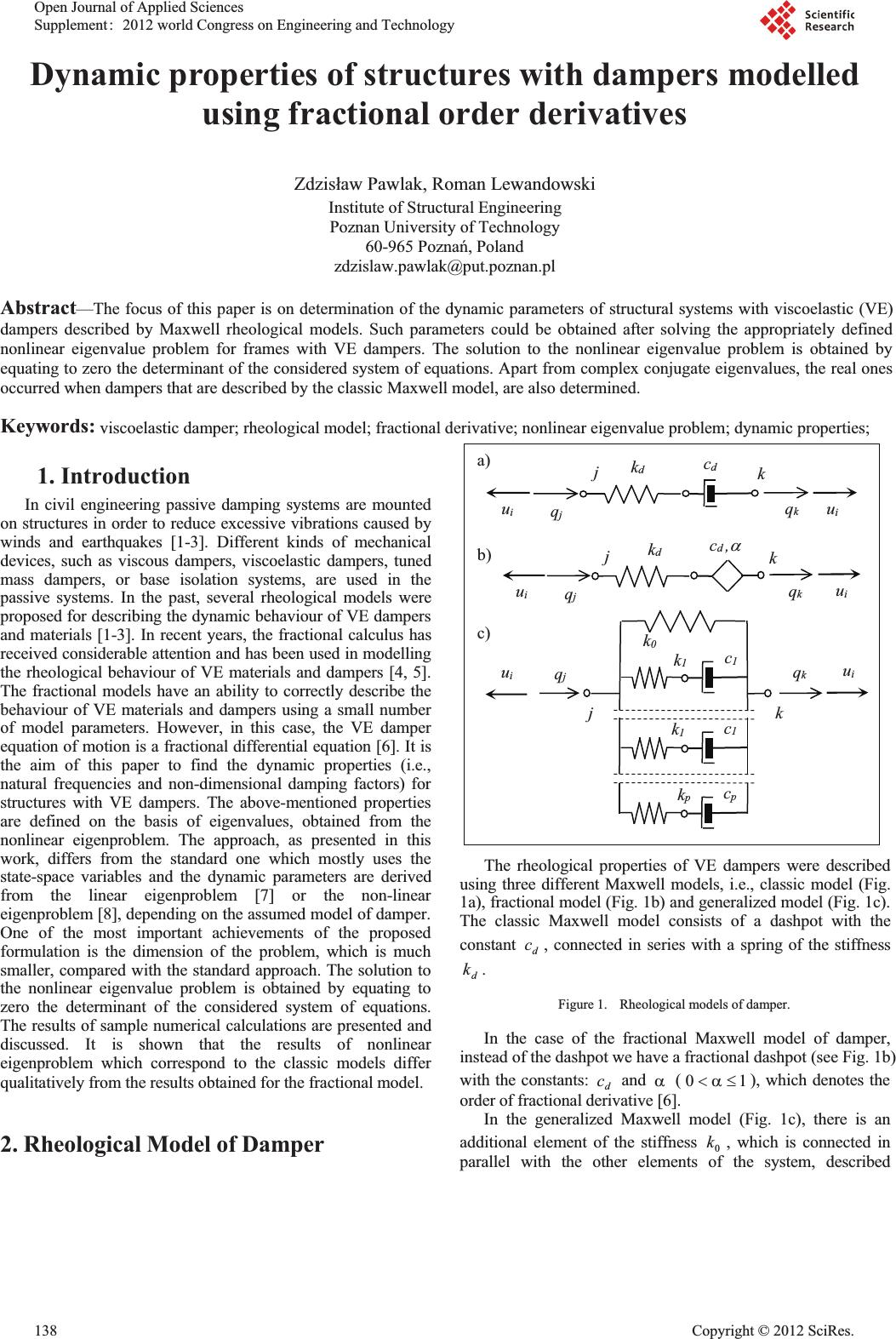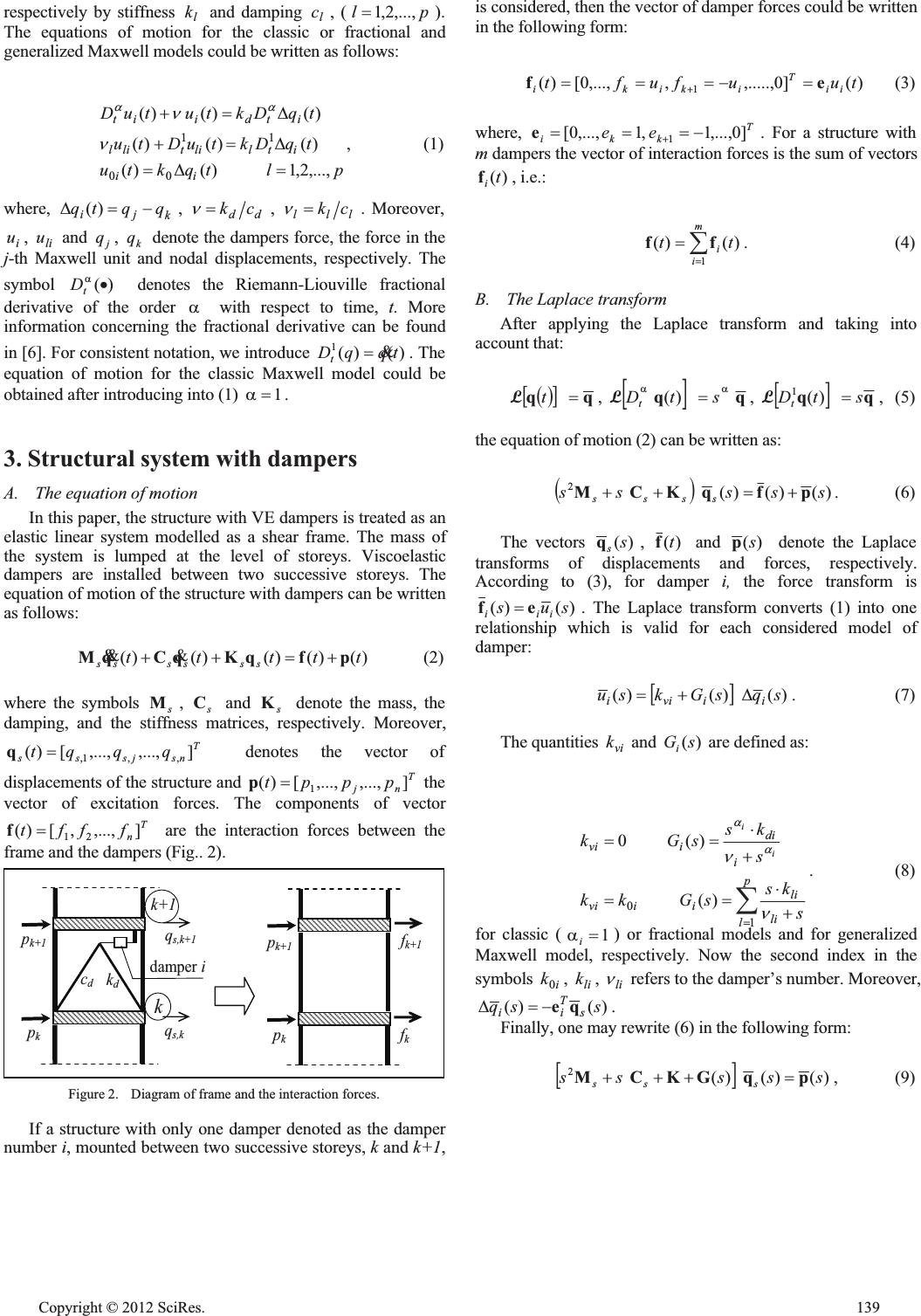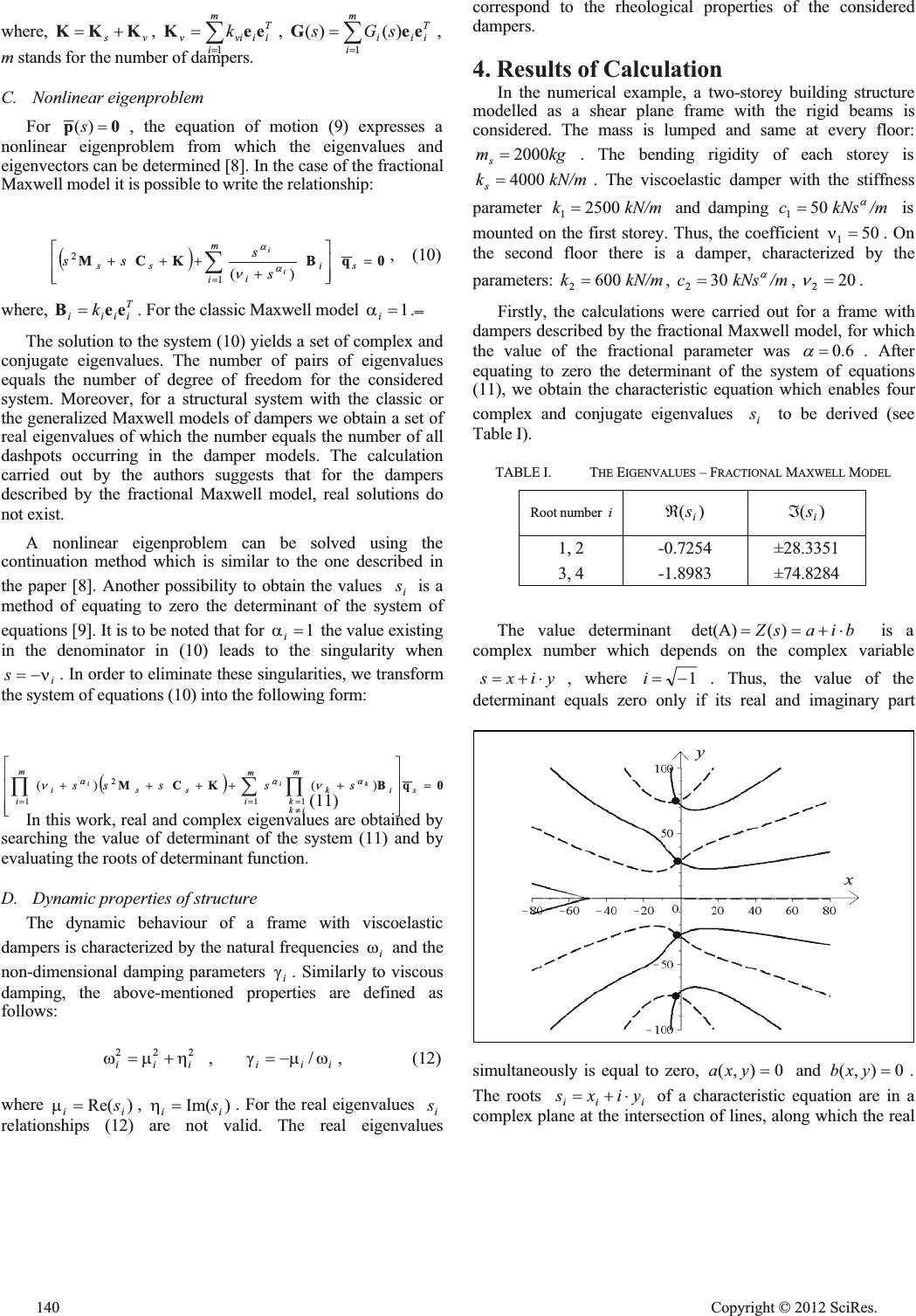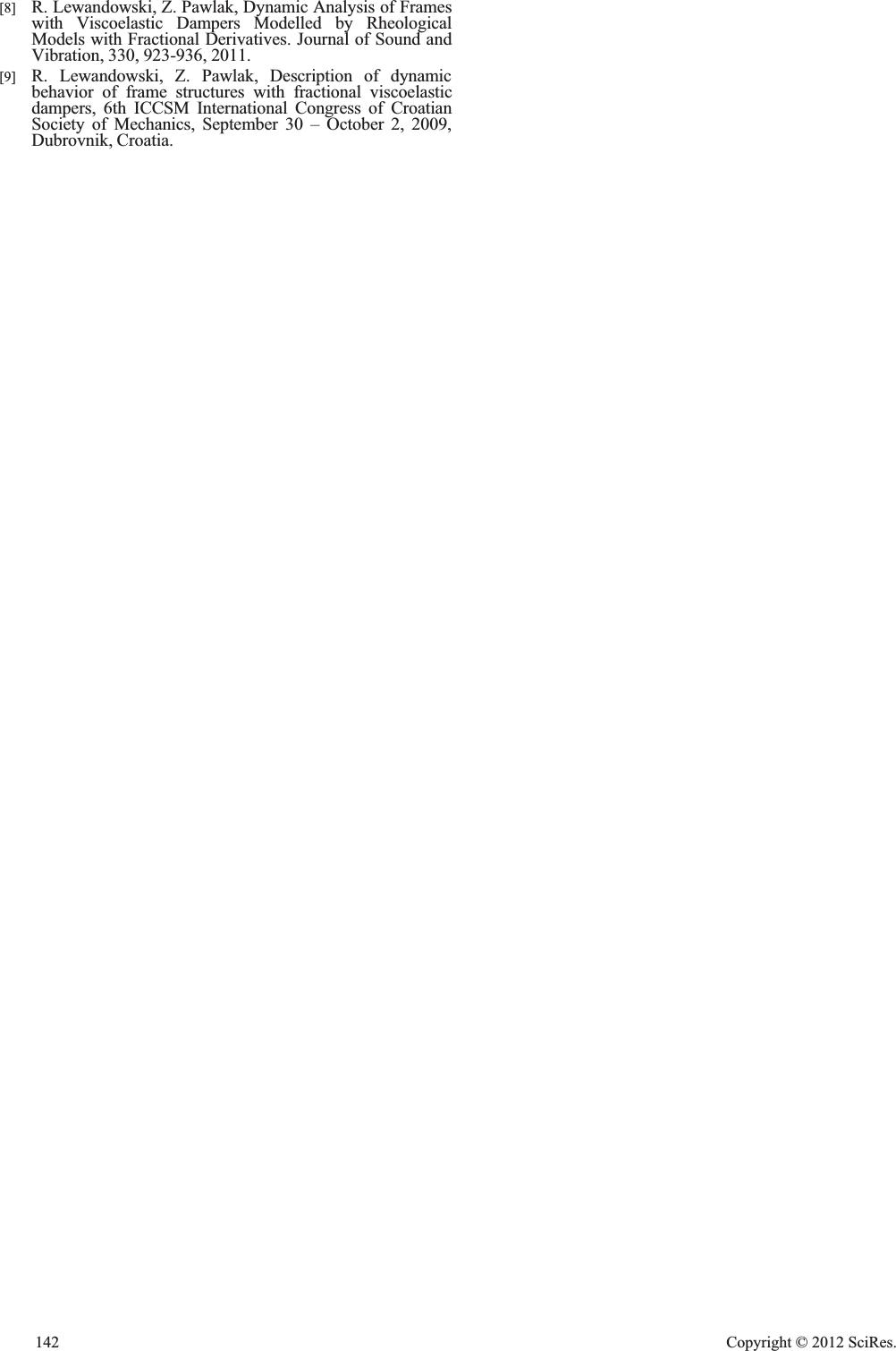Paper Menu >>
Journal Menu >>
 a) b) c) Dynamic properties ofstructures with dampers modelled using fractional order derivatives Zdzisáaw Pawlak, Roman Lewandowski Institute of Structural Engineering Poznan University of Technology 60-965 PoznaĔ, Poland zdzislaw.pawlak@put.poznan.pl Abstract—The focus of this paper is on determination of the dynamic parametersof structural systems with viscoelastic(VE) dampers described by Maxwell rheological models. Such parameters could be obtained after solvingthe appropriately defined nonlinear eigenvalue problem for frames with VE dampers. The solution to the nonlinear eigenvalue problemis obtained by equating tozero thedeterminantof theconsidered systemof equations.Apart fromcomplexconjugate eigenvalues,the real ones occurred when dampers that are described by the classic Maxwell model, are also determined. Keywords: viscoelastic damper; rheological model; fractional derivative; nonlinear eigenvalue problem; dynamic properties; 1. Introduction In civil engineering passive damping systems are mounted on structures in orderto reduce excessive vibrations caused by winds and earthquakes [1-3]. Different kinds ofmechanical devices, suchas viscousdampers, viscoelasticdampers,tuned mass dampers, or base isolation systems, are used in the passive systems.Inthe past, several rheologicalmodels were proposed for describing the dynamicbehaviourof VE dampers and materials[1-3].In recentyears,the fractionalcalculushas received considerable attention and has been used in modelling the rheologicalbehaviourof VE materialsanddampers [4, 5]. The fractional models have an abilitytocorrectlydescribethe behaviour of VEmaterials and dampers using a small number of model parameters. However, in this case, the VEdamper equation ofmotion isa fractionaldifferential equation [6].It is the aim of this paper to find the dynamic properties (i.e., natural frequenciesand non-dimensionaldamping factors)for structures with VE dampers. The above-mentionedproperties aredefinedonthebasisofeigenvalues,obtainedfromthe nonlinear eigenproblem.Theapproach,as presentedin this work, differs fromthe standard one whichmostly uses the state-space variablesand thedynamicparameters arederived from the lineareigenproblem [7] or the non-linear eigenproblem [8], dependingontheassumed model of damper. One of the most important achievements of the proposed formulationis thedimension ofthe problem,which ismuch smaller, compared with the standard approach. The solution to the nonlinear eigenvalue problem is obtained by equating to zero thedeterminantoftheconsideredsystem of equations. The results of sample numerical calculations arepresented and discussed. It is shownthat the results of nonlinear eigenproblem which correspond to the classic models differ qualitatively from the results obtainedfor the fractional model. 2. RheologicalModelof Damper The rheologicalproperties of VE dampers weredescribed using three different Maxwellmodels, i.e., classic model (Fig. 1a), fractional model (Fig. 1b)andgeneralized model (Fig. 1c). TheclassicMaxwell model consists of a dashpot with the constant d c, connected in series with a spring of the stiffness d k. Figure 1.Rheologicalmodels of damper. In the caseofthefractionalMaxwellmodelofdamper, instead of the dashpot we havea fractional dashpot (see Fig. 1b) with theconstants:d cand D(10 dD ), which denotesthe order of fractionalderivative [6]. In the generalized Maxwellmodel (Fig. 1c),thereisan additional element of the stiffness0 k, whichisconnected in parallel with the other elementsof the system, described cd qk qj kd ui k j ui ui ui cd, D qk qj k dk j k0 k1c1 k1c1 kpcp qk k ui uiqj j Open Journal of Applied Sciences Supplement:2012 world Congress on Engineering and Technology 138 Cop y ri g ht © 2012 SciRes.  qs,k k kd cd qs,k+1 pk pk+1 k+1 damper i fk fk+1 pk pk+1 respectively by stiffnessl kand dampingl c,( pl ,...,2,1 ). The equations ofmotionforthe classic or fractionaland generalized Maxwell models could be written as follows: pltqktu tqDktuDtu tqDktutuD ii itllitlil itdiit ,...,2,1)()( )()()( )()( )( 00 11 ' ' ' Q Q DD where, k ji qqtq ')( ,dd ck Q ,lll ck Q . Moreover, i u,li uand j q,k qdenote thedampersforce, theforce inthe j-thMaxwellunit andnodaldisplacements,respectively.The symbol )(x D t Ddenotes the Riemann-Liouville fractional derivative ofthe orderDwith respect totime, t. More information concerning the fractionalderivative can befound in [6].Forconsistentnotation,we introduce)()( 1tqqDt .The equation of motion for the classic Maxwell model could be obtained after introducing into(1)1 D. 3. Structuralsystemwithdampers A.The equation of motion In this paper,thestructure with VE dampersistreated as an elastic linearsystemmodelled as ashear frame. Themassof the system is lumped at thelevelof storeys.Viscoelastic dampers areinstalled between twosuccessive storeys. The equation ofmotion ofthe structurewith damperscanbe written as follows: )()()()()(ttttt ssssss pfqKqCqM where the symbolss M,s Cand s Kdenote the mass, the damping,and thestiffnessmatrices,respectively. Moreover, T nsjsss qqqt ],...,,...,[)( ,,1, qdenotes the vector of displacements ofthe structure andT nj pppt ],...,,...,[)( 1 pthe vector of excitation forces. The components of vector T n ffft ],...,,[)( 21 farethe interactionforces betweenthe frame and thedampers (Fig.. 2). Figure 2.Diagram of frame and the interaction forces. If a structure with onlyone damper denoted as the damper number i, mounted between two successivestoreys, kand k+1, isconsidered, thenthe vectorofdamper forcescouldbe written in the followingform: )(]0,.....,,,...,0[)( 1tuufuft ii T ikikief where, T kki ee ]0,...,1 ,1,...,0[1 e. For a structure with mdampersthe vector ofinteraction forces isthesum of vectors )(t i f, i.e.: ¦ m i itt 1 )()( ff B.The Laplace transform After applying the Laplace transform and taking into account that: >@ qq tL >@ qq DD stDt)(L >@ qqstDt )( 1 L the equation of motion (2) can be written as: )()()( 2sssss ssss pfqKCM The vectors)(s s q,)(tfand )(spdenote the Laplace transforms of displacements and forces, respectively. According to(3), for damperi, the forcetransform is )()( sus iii ef . The Laplace transformconverts (1)into one relationship which is validfor each consideredmodel of damper: >@ )()()( sqsGksuiivii ' The quantitiesvi kand )(sGiare defined as: ¦ p lli li iivi i di ivi s ks sGkk s ks sGk i i 1 0)( )(0 Q Q D D for classic (1 Di) or fractional models and for generalized Maxwell model, respectively. Nowthe secondindex inthe symbols i k0,li k,li Q refers to the damper’s number. Moreover, )()( ssq s T ii qe '. Finally, one may rewrite (6) inthe following form: >@ )()()( 2sssss sss pqGKCM Cop y ri g ht © 2012 SciRes.139  y x where, vs KKK ,¦ m i T iiviv k 1 eeK ,¦ m i T iiisGs 1 )()( eeG , mstands for thenumber of dampers. C.Nonlineareigenproblem For 0p )( s, theequation ofmotion (9)expresses a nonlinear eigenproblem from which the eigenvalues and eigenvectors canbe determined [8].In the caseofthe fractional Maxwell model itis possible to write the relationship: 0qBKCM » » ¼ º « « ¬ ª ¦ si m ii ss i i s s ss 1 2 )( D D Q where, T iiii keeB . For the classic Maxwell model1 Di. Thesolution tothe system(10)yieldsa set ofcomplexand conjugate eigenvalues.The numberof pairs ofeigenvalues equals the number of degreeof freedomfortheconsidered system. Moreover, for a structural system with theclassicor thegeneralized Maxwell models ofdampers weobtain a set of real eigenvalues of which the number equals thenumber of all dashpots occurring inthe damper models. The calculation carried out bythe authors suggests thatfor thedampers described by the fractional Maxwell model, real solutions do not exist. A nonlineareigenproblem canbe solvedusing the continuation methodwhichis similar to the one described in the paper[8].Anotherpossibility to obtain the valuesi s is a method of equating to zero the determinant of the system of equations[9]. Itis to benoted thatfor1 Dithevalueexisting in the denominator in (10) leads to the singularity when i sQ . In order to eliminate these singularities, we transform the systemof equations (10)into the following form: 0qBKCM » » » » ¼ º « « « « ¬ ª ¦ z si m i m ik k kss m i ikii sssss 11 2 1 )()( DDD QQ In this work,real and complexeigenvalues are obtained by searching the value of determinantof the system (11) and by evaluating the roots ofdeterminant function. D.Dynamic properties of structure The dynamic behaviourofa framewith viscoelastic dampers is characterized by the natural frequenciesi Zand the non-dimensionaldampingparametersi J . Similarlyto viscous damping, the above-mentioned properties are defined as follows: iiiiii ZP JKP Z/, 222 where )Re(iis P ,)Im( ii s K . For the real eigenvaluesi s relationships (12) are not valid. The real eigenvalues correspond to the rheological properties of the considered dampers. 4. ResultsofCalculation In thenumericalexample, atwo-storeybuilding structure modelled asa shear planeframe with therigid beamsis considered. Themass is lumped and same at everyfloor: kgms2000 .The bending rigidity of each storey is kN/mks4000 . The viscoelastic damper with the stiffness parameter kN/mk2500 1 and damping/m kNsc D 50 1 is mounted on the first storey. Thus, the coefficient50 1 Q.On the second floor thereis a damper,characterized by the parameters: kN/mk600 2 ,/m kNsc D 30 2 ,20 2 Q . Firstly, the calculationswere carried out for aframe with dampers describedby thefractional Maxwellmodel, for which the valueof thefractional parameter was6.0 D . After equating to zero the determinant of thesystemofequations (11), weobtainthe characteristicequationwhich enables four complex and conjugate eigenvaluesi s to be derived (see Table I). TABLE I.THE EIGENVALUES–F RACTIONAL MAXWELLMODEL Rootnumberi)( i s)( i s 1, 2-0.7254±28.3351 3, 4-1.8983±74.8284 The value determinantbiasZ )(det(A) is a complex number which dependson thecomplex variable yixs , where1 i. Thus, the value of the determinant equals zeroonly if its real and imaginary part simultaneously isequalto zero,0),( yxa and 0),( yxb . The rootsiii yixs of a characteristicequationare in a complex planeat the intersectionof lines,along whichthe real 140 Cop y ri g ht © 2012 SciRes.  y x Im(Z) y x=-60 x=-50 x=-40 part isequal tozero(solid line inFig.3) and theimaginary part is equal to zero(dashed line inFig. 3). Figure 3.Plot of functions(Z) ,(Z) - fractional Maxwellmodel. In Fig. 3 one may observe foursuchintersectionpointsof which the coordinates coincide with the values given in Table I. Next, the dampers were modeled using the classic Maxwell model. The eigenproblem derived in the form of(11) was solved byequatingthe determinant ofthesystemof equations to zero.This leads to a characteristicequation of which the solution yields four complex, conjugate eigenvaluesi s and four real eigenvalues (seeTable II). TABLE II.THE EIGENVALUES –C LASSIC MAXWELL MODEL Rootnumberi)( i s)( i s 1, 2-2.9931±29.7644 3, 4-3.6167±80.3574 5 -17.6578 0 6-200 7 -39.1227 0 8-500 The rootsof thenumber 6 and8correspondto the solutions ii sQ , thatmeans a singular solutionof (10), which should not be treated as the eigenvalues. Forthesepoints, the value of the determinant,as derivedfromeigenproblem (10), tends to infinity. The discussed solutions are presented in Fig.4, as the points of intersectionof the zero level lines of the surface y))(Z(x, andsurfacey))(Z(x, derived from(11). Figure 4.Plotof functions(Z) and (Z) - classic Maxwell model. The real solutions5 sand 7 sgiven in TableII coincide with the rheological properties of dampers mountedin structure. 5. Concluding Remarks Comparing theresults of calculations fora frame with dampers modeled using the classic Maxwell model and the results obtained for the fractional Maxwell model, we may observe qualitative differences. Thesolution to the nonlinear eigenproblemleads toa numberof pairsofcomplex and conjugate eigenvaluesiii yixs r . Moreover, in the case of the classic Maxwellmodel of damper we obtain some real eigenvalues for0 i xand 0 i y. For the fractional Maxwell model, real solutionsdo not existbecauseof discontinuity in the imaginarypartofthe determinant),(det(A) yxZ (see Fig. 5). Figure 5.Diagram of imaginary partof determinant function. 6. Acknowledgment The authorswish to acknowledgethe financial support received fromthe Poznan University ofTechnology (Grant No. DS 11-088/12)in connection with thiswork. REFERENCES [1] S.W. Park,Anal y tical modellin g of viscoelastic dam p ers fo r structural an d vibration control. International Journal of Solids an d Structures, 38, 8065 – 8092, 2001. [2] C.Christo p oulos, A. Filiatrault, Princi p les of Passive Su pp lemental Dam p in g an d Seismic Isolation. IUSSPress, Pavia, Italy, 2006. [3] I.Takewaki,Buildin g control with p assive dam p ers, O p timal p erformance-base d desi g nfo r earth q uakes. Wile y an d Sons (Asia), Singapore, 2009. [4] R.L.Ba g le y , P. J. Torvik, Fractionalcalculus – a differen t a pp roach tothe anal y sis of viscoelasticall y dam p e d structures. AIAA Journal,27, 1412 – 1417, 1998. [5] T.Chan g ,M.P.Sin g h, Seismicanal y sis of structures with a fractionalderivativemodelof viscoelastic dam p ers. Earth q uake En g ineerin g an d En g ineerin g Vibration, 1, 251-260,2002. [6] I.Podlubn y , Fractional Differential E q uations. Academic Press, 1999. [7] R.Lewandowski,A. Bartkowiak,H. Macie j ewski, D y namic anal y sis of frames withviscoelasticdam p ers: a com p arison of dam p ers models, StructuralEn g ineerin g an d Mechanics, 41, 113-137, 2012. Cop y ri g ht © 2012 SciRes.141  [8] R.Lewandowski, Z. Pawlak, D y namic Anal y sis of Frames with Viscoelastic Dam p ers Modelle d by Rheolo g ical Models with Fractional Derivatives. Journal of Soun d an d Vibration, 330,923-936, 2011. [9] R.Lewandowski,Z. Pawlak,Descri p tion ofd y namic b ehavio r of frame structures withfractional viscoelastic dam p ers, 6th ICCSM International Con g ress of Croatian Societ y of Mechanics, Se p tembe r 30 – Octobe r 2, 2009, Dubrovnik,Croatia. 142 Cop y ri g ht © 2012 SciRes. |

